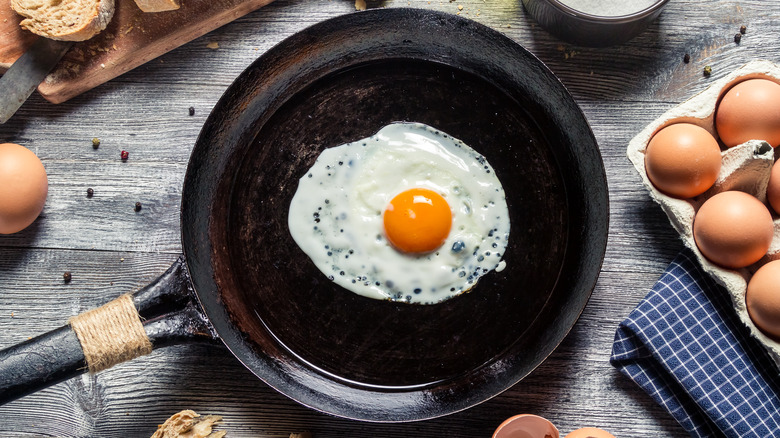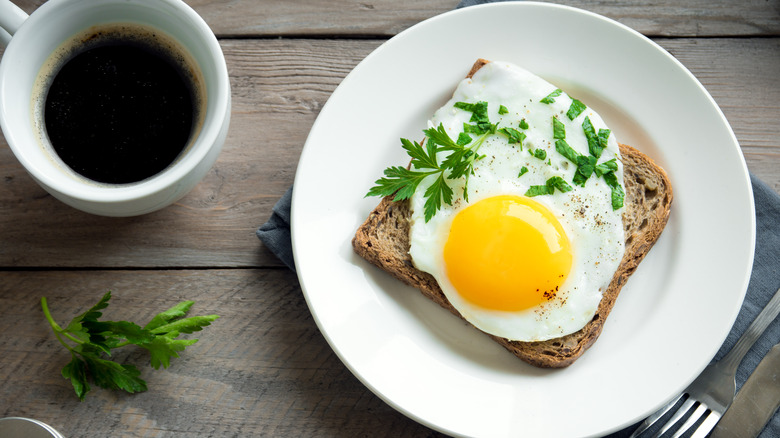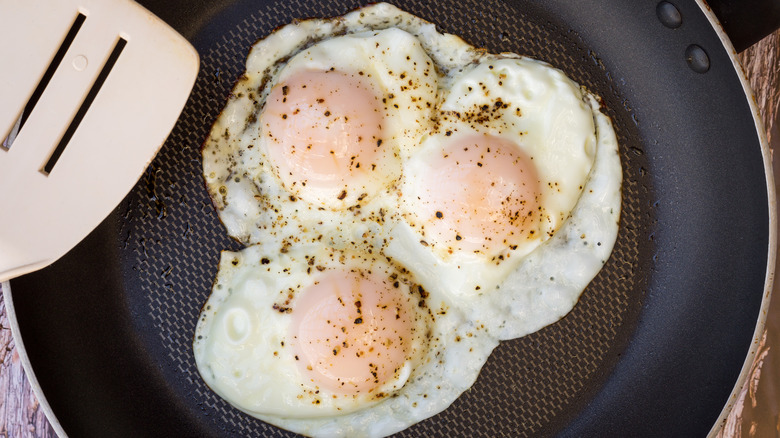What Makes Sunny-Side Up Eggs Different From Over-Easy?
In a world of endless egg cooking possibilities, sunny-side up and over-easy may be two of the more basic choices, but that means you should know how to do them right. Eggs are unique for many reasons, from their versatility in an amazing variety of dishes to their various health benefits. Still, one of the best things about them is how they can be enjoyed with simple preparations. Sure, you can whip them up into a soufflé, but eggs aren't beloved because they're fancy; they are loved because they are an incredibly delicious food you can make on a weekday morning in just a couple minutes.
Sunny-side up and over-easy eggs are two styles that are perfect for exactly that reason. While you can use both preparations in a myriad of ways, like topping ramen, they are also perfect on toast or eaten on their own with just a sprinkle of salt and pepper. But they have more in common than what you can eat them with.
According to A Couple Cooks, both styles get fried up on the stovetop, should leave you with a runny yolk, and can be made in just a few minutes. But there are a few notable differences in how they are prepared and what their ideal final form is. So what makes an over-easy egg different from sunny-side up?
What is a sunny-side up egg?
If you had to picture a cooked egg in your head, it would likely be a sunny-side up. It's the stock-photo egg, with its perfectly soft cooked white and still-runny yolk held in with a thin film. It can also be surprisingly tricky to pull off. As Kitchn notes, sunny-side up eggs are a delicate balancing act that involves getting the white to fully set while keeping the yolk soft. A bad sunny-side up egg that hasn't been fully cooked can have whites that take on a slimy, wet consistency. However, if you crank up the heat, you risk not only overcooking the whites but getting a hard, tacky yolk too.
Thankfully, there are a few guidelines you can follow to make excellent sunny-side up eggs without too much effort. First off, according to Delish, you want to cook at medium-low heat. And just three minutes of cooking time will give the whites the time to set but isn't long enough to cook the yolk through. You also want to use at least a tablespoon of butter or olive oil to help cook and crisp the bottom a bit. Another helpful tip, if you still have undercooked whites, is to use a lid for your pan, which can trap heat and gently cook the top of your eggs. It can take some practice to get the balance right, but a perfect sunny-side up egg is a thing of delicious beauty.
What is an over-easy egg?
If sunny-side up is the delicate, model egg dish, over-easy is its more forgiving, diner-style sibling. According to MasterClass, over-easy eggs start much the same way as sunny-side up, but instead of being left alone to slowly heat through, they get a quick flip and fry on the second side to make sure the whites are fully cooked. These too, get about three minutes on medium-low heat, but you don't want to spend too much time cooking the second side — about 30 seconds should do. If you let it go much longer, the heat will start cooking through the yolk, and you'll end up in "over-hard" territory. Over-easy eggs are an easier way to get a runny yolk and tender whites, but they will end up a little bit more cooked and are a bit less Instagram-worthy than their sunny-side up relative.
The trickiest part of over-easy eggs is not breaking the yolk when you flip it. Today states that you should be using either a seasoned cast-iron or nonstick pan, and with enough fat to make sure both sides of the egg won't fuse to the cooking surface. A thin spatula that's wide enough to pick up the whole egg will also make the job a lot easier. Try to flip the egg over in one steady motion, and don't throw it down too hard. The yolk side should separate from the pan as soon as the whites are cooked, and then it's off to top some hash browns or avocado toast.


